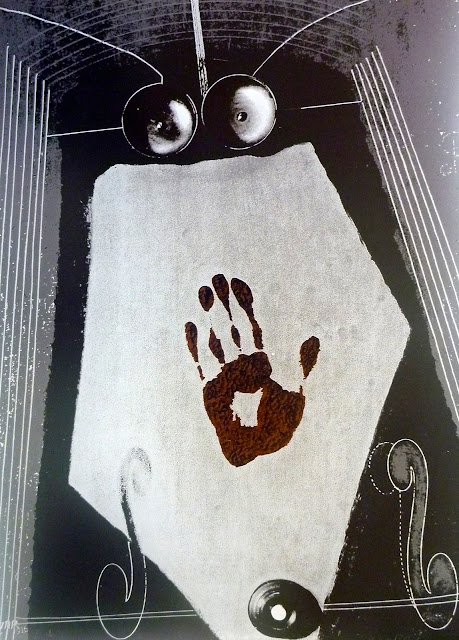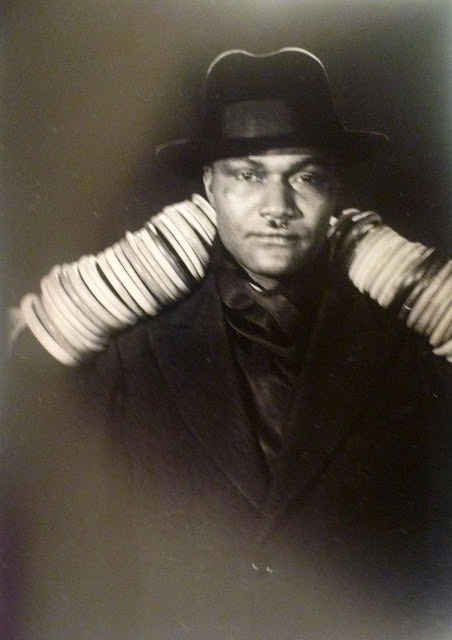Man Ray, at the National Portrait Gallery.
One of the 20th century's great visual innovators, May Ray was constantly in pursuit of new forms, whether in paint, sculpture, film, rayographs or solarised images. He gave up painting in favour of photography in 1922. 'It was Man Ray's achievement to treat the camera as he treated the paintbrush, a mere instrument at the service of his mind', commented Marcel Duchamp. Angry at photography's lesser status in the view of many followers of contemporary art, Man Ray once said: 'Everyone will tell you that I am not a painter. That is true. At the beginning of my career, I once classed myself as a photometrographer. My works are purely photometric'. Having photographed the majority of the artists amongst whom he moved, Man Ray's portraits have become the definitive images of those individuals. His images are record-keeping, testimony and memorials, and he made modernity visible in the process.
He alligned himself with the Dadaist and Surrealist movements and adopted methods advocated by them even though he never joined officially either of those movements. He was always open to new ideas, even to the happenstance of hasard objectif (objective chance) so that when a blurred exposure multiplied the eyes of Marchesa Casati he recognised the potential of his error:
Marchesa Casati
He liked to say that he could 'produce accidents at will'.
New York, 1916-20
Self-Portrait, 1916
Marcel Duchamp, N.Y., 1916
Marcel Duchamp as Belle Haleine, 1921
Duchant in drag in his persona of Rrose Selavy, this image, a real icon of modernity.
Woman Smoking a Cigarette, 1920
Paris 1921-8
Noire et Blanche, 1926
Kiki de Montparnasse, her white face twinned with an African mask
A different version of Noire et Blanche, 1926
Ernest Hemingway, 1923
James Joyce, 1922
His original use of lighting make the portraits original and unmistakable, as is the case here, James Joyce's tired eyes downcast in deep shadow.
Alice B. Toklas and Gertrude Stein, 1922
Pablo Picasso, 1923
Jacques Rigaut, 1922
Marcel Duchamp and Comte Raoul de Roussy de Salles playing chess in Man Ray's studio, 1925
Jean Cocteau, 1922
Genica Athanasiou, 1921
Peggy Guggenheim in a dress by Paul Poiret, 1924
He sometimes manipulated the light to create luminographs and rayographs (the halo effects of solarisation) to create multiple ripples and reflections as in Peggy Guggenheim's dress in this photograph.
Iris Tree, 1923
Ivor Stravinsky, 1923
Adam and Eve (Marcel Duchamp and Brogna Perlmutter) 1924-5
Tristan Tzara and Jean Cocteau, 1921-22
Louis Aragon and Andre Breton, 1924
Berenice Abbott, 1921
Marie Laurencin, 1923
Le Violon d'Ingres, 1924
Kiki De Monparnasse from the back - a visual pun - an Ingres odalisque incarnate. The f-shaped scrolls traced on her torso turn her into a violin, and the work's title refers to the painter's love of the instrument.
Helene Perdriat, 1925
Self-Portrait, 1924
Serge Lifar as Romeo in Romeo and Juliet, 1925
Barbette, 1926
Rose Wheeler, 1926
Rose Covarrubias, 1928
Henri Matisse, 1925
Nancy Cunard, 1926
Nancy Cunard laden with bangles
Henry Crowder, 1928-30
Henry Crowder with Nancy Cunard's bracelet laden arms around his head.

































No comments:
Post a Comment